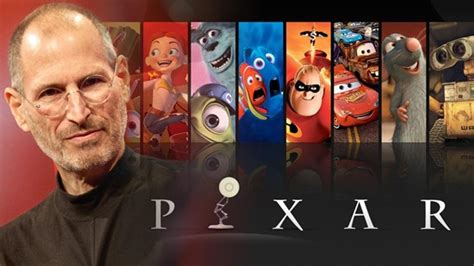Steve Jobs In Pixar

The name Steve Jobs is synonymous with innovation and technological brilliance, and his impact on the world of computing and technology is undeniable. However, Jobs' influence extended beyond the realm of personal computers and smartphones. In this article, we delve into the lesser-known but equally fascinating role Steve Jobs played in the world of animation, specifically his involvement with Pixar Animation Studios.
Steve Jobs' journey with Pixar began in 1986 when he purchased the computer graphics division of Lucasfilm Ltd., a film production company founded by Star Wars creator George Lucas. This division, which included a talented team of artists and technicians, would later become Pixar Animation Studios. Jobs' acquisition marked the beginning of a remarkable transformation, as he guided Pixar from a small graphics hardware company to one of the most influential and successful animation studios in history.
A New Era for Animation

When Steve Jobs acquired Pixar, the traditional animation industry was dominated by hand-drawn techniques, with studios like Disney leading the way. However, Jobs had a vision for the future of animation, and he believed in the potential of computer-generated imagery (CGI) to revolutionize the industry. With his characteristic passion and drive, he set out to prove that CGI could not only match but surpass the quality and emotional depth of traditional animation.
Under Jobs' leadership, Pixar developed cutting-edge technology and pioneered new animation techniques. The studio's early years were dedicated to creating groundbreaking short films that showcased the capabilities of CGI. One of their earliest successes was the short film Tin Toy (1988), which won an Academy Award for Best Animated Short Film. This achievement not only validated Jobs' belief in CGI but also demonstrated Pixar's ability to create emotionally resonant stories using computer-generated characters.
The Birth of a Cinematic Revolution
Pixar's true breakthrough came with the release of Toy Story in 1995. Directed by John Lasseter, who would later become Pixar's Chief Creative Officer, Toy Story was the first feature-length computer-animated film. It marked a turning point in the history of animation, proving that CGI could not only compete with traditional animation but also capture the imagination of audiences worldwide.
| Pixar's Early Milestones | Year |
|---|---|
| Acquisition by Steve Jobs | 1986 |
| Release of Tin Toy | 1988 |
| Release of Toy Story | 1995 |

With Toy Story, Pixar not only introduced the world to a new animation style but also created a beloved cast of characters that resonated with audiences of all ages. The film's success paved the way for a new era of computer-animated films, and Pixar quickly became synonymous with innovation and excellence in the field.
Steve Jobs' Leadership and Vision

Steve Jobs' involvement with Pixar was more than just a financial investment; it was a labor of love and a testament to his belief in the power of storytelling and innovation. As Pixar's largest shareholder and chairman of the board, Jobs played a crucial role in shaping the studio's direction and culture.
Jobs' influence extended to every aspect of Pixar's operations. He was known for his hands-on approach, often providing feedback on storyboards, character designs, and even the tiniest details of animation sequences. His meticulous attention to detail and relentless pursuit of perfection pushed Pixar's artists and technicians to new heights, ensuring that every film they produced met the highest standards of quality.
Collaboration and Creativity
One of the key aspects of Jobs' leadership at Pixar was his ability to foster a collaborative and creative environment. He understood the importance of bringing together diverse talents and encouraging open communication. Pixar's unique culture, often referred to as the "Pixar way," emphasized collaboration, trust, and a shared passion for storytelling.
Jobs' support for his creative team extended beyond the studio walls. He was a strong advocate for the studio's films, often personally promoting them to industry executives and distributors. His belief in the power of Pixar's stories and characters helped secure the studio's reputation and paved the way for future successes.
Pixar's Legacy and Impact
Steve Jobs' impact on Pixar was immeasurable, and the studio's success and influence in the animation industry are a testament to his vision and leadership. Under his guidance, Pixar became a powerhouse of creativity and innovation, producing a string of critically acclaimed and commercially successful films.
Pixar's early films, such as A Bug's Life (1998), Toy Story 2 (1999), and Monsters, Inc. (2001), solidified the studio's reputation as a leader in computer animation. These films not only pushed the boundaries of CGI technology but also showcased the studio's ability to craft engaging and emotionally rich stories.
The Golden Age of Pixar
The early 2000s marked a golden age for Pixar, as the studio released a series of films that became cultural touchstones. Finding Nemo (2003), The Incredibles (2004), and Ratatouille (2007) not only delighted audiences but also garnered critical acclaim and numerous awards, including Academy Awards for Best Animated Feature.
Pixar's success extended beyond the box office. The studio's films became cultural phenomena, with iconic characters and memorable quotes seeping into popular culture. The studio's commitment to storytelling, combined with its technical prowess, created a unique brand of animation that resonated with audiences globally.
| Pixar's Golden Age Films | Year |
|---|---|
| Finding Nemo | 2003 |
| The Incredibles | 2004 |
| Ratatouille | 2007 |
The Lasting Influence
Steve Jobs' involvement with Pixar ended in 2006 when the studio was acquired by The Walt Disney Company. However, his legacy at Pixar lives on. The studio continues to produce critically acclaimed and commercially successful films, such as WALL-E (2008), Up (2009), Inside Out (2015), and Soul (2020), among others.
Jobs' influence can be seen in Pixar's commitment to pushing the boundaries of animation technology and storytelling. The studio's success has inspired a new generation of animators and filmmakers, fostering a thriving ecosystem of computer-generated animation studios and talent.
The Future of Pixar
As Pixar continues to innovate and delight audiences, Steve Jobs' vision for the future of animation remains a guiding principle. The studio's ability to combine cutting-edge technology with heartfelt storytelling is a testament to Jobs' belief in the power of creativity and innovation. Pixar's enduring success is a lasting tribute to the man who saw the potential in computer-generated imagery and helped shape the future of animation.
What was Steve Jobs’ role at Pixar?
+Steve Jobs was the largest shareholder and chairman of the board at Pixar. He played a crucial role in the studio’s direction and culture, providing feedback and support for its creative team.
How did Pixar revolutionize animation?
+Pixar introduced computer-generated imagery (CGI) to the world of animation, proving that it could rival and surpass traditional animation techniques. Their films, starting with Toy Story, showcased the potential of CGI to create emotionally resonant stories and characters.
What is the “Pixar way”?
+The “Pixar way” refers to the studio’s unique culture, which emphasizes collaboration, trust, and a shared passion for storytelling. This culture was fostered by Steve Jobs and has become a hallmark of Pixar’s success and creativity.


